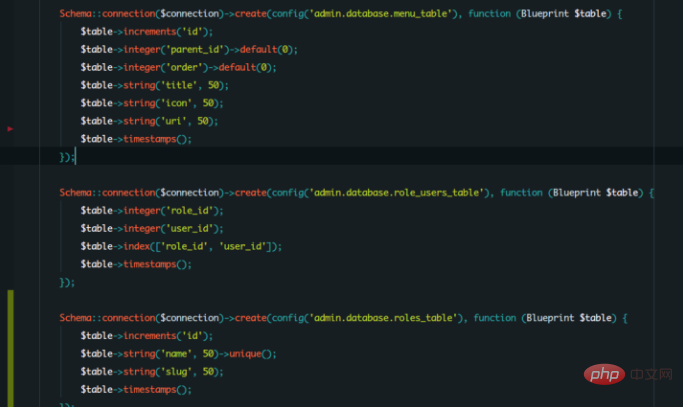Home >PHP Framework >Laravel >A brief analysis of the principles of Laravel Auth
The following is a brief analysis of the principles of Laravel Auth from the Laravel tutorial column. I hope it will be helpful to friends in need!

Since the company has recently used Laravel-admin as the backend and has been exposed to the Laravel framework, I have to say that the power and ecology of the Laravel community are indeed quite powerful.
However, the company’s internal business is all on the Java side, and all the backend is to adjust JavaApi, so the features of Laravel have to be greatly reduced. First of all, the Eloquent model cannot be used at all. I separate the business here and only save There are 3 tables, which are the tables that come with Laravel-admin.

Laravel-admin comes with 9 tables. Since the user login business is all stored on the API side, I gave up the built-in table function. Therefore, you need to implement the Api login logic yourself, and you must use Laravel Auth authentication.
Principle Interpretation
// 使用下面这个命令Laravel会自动为我们生成Auth路由和认证模块。跟着代码往下解读。 php artisan make:auth // Http/Controllers/Auth/LoginController 使用了 AuthenticatesUsers
Among them, the following three methods explain all the login logic.
public function login(Request $request)
{
$this->validateLogin($request);
if ($this->hasTooManyLoginAttempts($request)) {
$this->fireLockoutEvent($request);
return $this->sendLockoutResponse($request);
}
// 这里尝试登录系统,
if ($this->attemptLogin($request)) {
return $this->sendLoginResponse($request);
}
$this->incrementLoginAttempts($request);
return $this->sendFailedLoginResponse($request);
}
protected function attemptLogin(Request $request)
{
return $this->guard()->attempt(
$this->credentials($request), $request->has('remember')
);
}
protected function guard()
{
return Auth::guard();
}The controller will look for Auth::guard(), so what is this Auth::guard()?
First of all, Auth is the singleton of the system, and the prototype is in
Illuminate\Auth\AuthManager;
As the name suggests, it is an Auth management module that implements the authentication factory mode interface guards().
public function __construct($app)
{
$this->app = $app;
$this->userResolver = function ($guard = null) {
return $this->guard($guard)->user();
};
}
// Auth::guard();就是调用了这个方法。
public function guard($name = null)
{
// 首先查找$name, 没有就使用默认的驱动,
$name = $name ?: $this->getDefaultDriver();
// 意思就是要实例化出这个驱动并且返回,
return isset($this->guards[$name])
? $this->guards[$name]
: $this->guards[$name] = $this->resolve($name);
}
// 默认的驱动是从配置文件里面读取的,/config/auth.php default配置项
public function getDefaultDriver()
{
return $this->app['config']['auth.defaults.guard'];
}
// 这里是构造Auth-guard驱动
protected function resolve($name)
{
$config = $this->getConfig($name);
if (is_null($config)) {
throw new InvalidArgumentException("xxx");
}
// 这里是如果你自己实现的驱动就返回
if (isset($this->customCreators[$config['driver']])) {
return $this->callCustomCreator($name, $config);
}
// 这里是系统默认两个类分别是
// session 和 token 这里主要讲 sessionGuard .
$driverMethod = 'create'.ucfirst($config['driver']).'Driver';
if (method_exists($this, $driverMethod)) {
return $this->{$driverMethod}($name, $config);
}
throw new InvalidArgumentException("xxx");
}Next, take a look at the configuration file auth.php
// Auth::guard() ,不传参数,就调用默认的default.guard ,
'defaults' => [
'guard' => 'web',
'passwords' => 'users',
],
// 系统的guard .默认支持 "database", "eloquent",意思就是说你的provider必须是这两个实例中的一个,
'guards' => [
'web' => [
'driver' => 'session',
'provider' => 'users',
],
'api' => [
'driver' => 'token',
'provider' => 'users',
],
],
// 这个就是上面的provider了,你使用哪一个provider作为你的Auth::guard()返回的
// 模型
'providers' => [
'users' => [
'driver' => 'eloquent',
'model' => App\User::class,
],
// 'users' => [
// 'driver' => 'database',
// 'table' => 'users',
// ],
],In other words, after all After all, Auth::guard(), in the default configuration, returns a sessionGuard to me.
Mainly look at the following four methods
namespace Illuminate\Auth;
class SessionGuard{
public function attempt(array $credentials = [], $remember = false)
{
// 这里触发 试图登录事件,此时还没有登录
$this->fireAttemptEvent($credentials, $remember);
$this->lastAttempted =
$user = $this->provider->retrieveByCredentials($credentials);
// 这里会调用hasValidCredentials,其实就是验证用户名和密码的一个过程
if ($this->hasValidCredentials($user, $credentials)) {
// 如果验证通过了,就调用login方法 .
$this->login($user, $remember);
return true;
}
// 否则就触发登录失败事件,返回假
$this->fireFailedEvent($user, $credentials);
return false;
}
// 这里是登录用户的操作,就是说调用这个方法已经是合法用户了,必须是一个
// AuthenticatableContract 的实例 .
public function login(AuthenticatableContract $user,
$remember = false)
{
// 直接更新session,这里就是把session存起来,session的键在该方法的
// getName() 里边,
$this->updateSession($user->getAuthIdentifier());
if ($remember) {
$this->ensureRememberTokenIsSet($user);
$this->queueRecallerCookie($user);
}
// 触发登录事件,已经登录了这个时候,
$this->fireLoginEvent($user, $remember);
// 将user对象保存到sessionGuard , 后续的类访问Auth::user();直接拿到
$this->setUser($user);
}
// 这里就是经常使用到的 Auth::user()了,具体如何返回看AuthManager里面的
// __call
public function user()
{
if ($this->loggedOut) {
return;
}
if (! is_null($this->user)) {
return $this->user;
}
// 这里读取session拿到user的id ,
$id = $this->session->get($this->getName());
$user = null;
// 如果拿到了id ,查找到该user
if (! is_null($id)) {
if ($user = $this->provider->retrieveById($id)) {
$this->fireAuthenticatedEvent($user);
}
}
$recaller = $this->recaller();
if (is_null($user) && ! is_null($recaller)) {
$user = $this->userFromRecaller($recaller);
if ($user) {
$this->updateSession($user->getAuthIdentifier());
$this->fireLoginEvent($user, true);
}
}
return $this->user = $user;
}
// 这里就直接返回用户id了,
public function id()
{
if ($this->loggedOut) {
return;
}
return $this->user()
? $this->user()->getAuthIdentifier()
: $this->session->get($this->getName());
}
}Generally speaking, the user login process is complete. The simple process is
//伪代码
$credentials = $request()->only(['username' ,'password']);
if(Auth::guard("session")->attempt($credentials)){
// 登录成功
}else{
// 登录失败
}Implementing a controller/method that can only be accessed after the user logs in
Route::get("/home")->middleware("auth");
// auth Middleware 是在app/Http/Kernel中注册的,
// 类名是 \Illuminate\Auth\Middleware\Authenticate::class
// 解析过程实质上是这个方法:
public function handle($request, Closure $next, ...$guards)
{
$this->authenticate($guards);
return $next($request);
}
protected function authenticate(array $guards)
{
// 默认情况下会去 Auth中寻找authenticate这个方法
if (empty($guards)) {
return $this->auth->authenticate();
}
// 如果middleware中传了参数,会遍历一遍,不通过就抛出异常
foreach ($guards as $guard) {
if ($this->auth->guard($guard)->check()) {
return $this->auth->shouldUse($guard);
}
}
throw new AuthenticationException('Unauthenticated.', $guards);
}
//sessionGuard 中的authenticate其实也就是调用了一遍user方法。
public function authenticate()
{
if (! is_null($user = $this->user())) {
return $user;
}
throw new AuthenticationException;
}This is my first time writing an article. If there are any errors, please point them out. Thank you!
The above is the detailed content of A brief analysis of the principles of Laravel Auth. For more information, please follow other related articles on the PHP Chinese website!